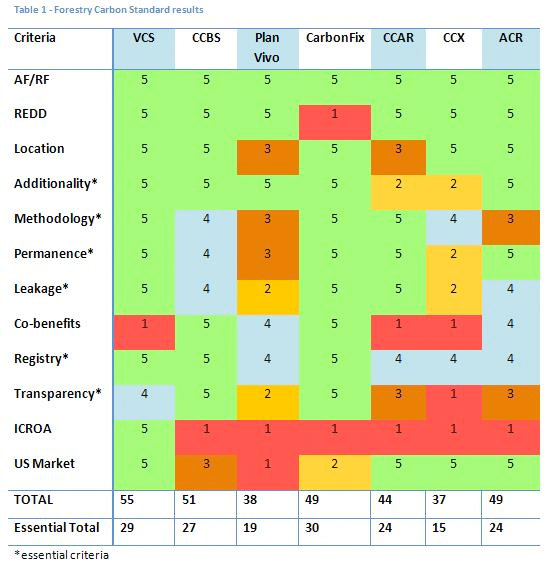The Voluntary Carbon Standard (VCS) tops the rankings of a recent assessment gauging various standards for forestry carbon credits.
The review, conducted by Paulo Lopes of Imperial College-London, found that VCS scores the best across a range of criteria to ensure that carbon credits are “real, verified, permanent, additional and unique”.
Lopes also evaluated the Climate, Community & Biodiversity Standard (CCBS), Plan Vivo, CarbonFix, the California Climate Action Registry (CCAR), the Chicago Climate Exchange (CCX), and the American Carbon Registry (ACR), and the Neo Forestry Carbon Standard.
In interpreting the results, Lopes notes that certain standards may be appropriate for different objectives: “Different organizations will have different interests with carbon credits; therefore they should be looking at the score of the relevant criteria and not the total score.”
The assessment can be found at reducecarbon.wordpress.com.
 Afforestation/ Reforestation – Appraise if the standard accepts afforestation/ reforestation projects and any singularity from a particular standard. Because this is a yes/no answer, the score will be 1 for NO and 5 for YES. REDD – Ascertain if the standard accepts REDD projects and any singularity from a particular standard. Because this is a yes/no answer, the score will be 1 for NO and 5 for YES. Location – This criterion will analyze any limitations in the location of projects. The more locations accepted, in order for a project to begin, the higher the score (up to 5). Additionality – This criterion will look at how projects must demonstrate additionality. The standard that provides the most detailed information on additionality will score the most. Methodology – The methodology and baseline will also be discussed. This criterion will analyze how standards use methodologies to approve the projects. The more detailed methodologies will receive the higher scores; the less detailed will receive the lower scores. Permanence – Analysis of how permanence is dealt with in the different standards. The highest score will go to the standard that assures the most permanent carbon credits. Leakage – Examination on how leakage is dealt with in the different standards. Standards that provide the best mechanisms to minimize leakage will receive the higher score. Co-benefits – Assessment of co-benefits and how they are included in the standard. The more co-benefits a standard accounts for, the more points it will receive. Registry – Inspection of the mechanisms to reduce the possibility of double accounting. The greater assurance a standard will give to double counting the more points it will receive. Transparency – The more information on the project that is accessible to the public and the more public consultation provided; the more points to add. ICROA – International Carbon Reduction Offset Alliance (ICROA) was formed to provide a code of best conduct in the carbon market and currently serves thousands of businesses and individuals. ICROA members can only trade credits from CDM, JI, GS and VCS. A standard that is not accepted by ICROA will produce credits that a large part of the market will not accept. This criterion will check if the standard is accepted or not by ICROA. Because this is a yes/no answer, the score will be 1 for NO and 5 for YES. US Market – As the US market will be the most important market for forestry projects. A standard that is not popular in the US will not endure. This criterion will analyze the likelihood for the standard to be widely accepted in the US market. The more likely, the higher the score will be. |
Paulo Lopes (2009). “Review of Forestry Carbon Standards – Development of a tool for organizations to identify the most appropriate forestry carbon credit.” Imperial College London, Faculty of Natural Sciences.